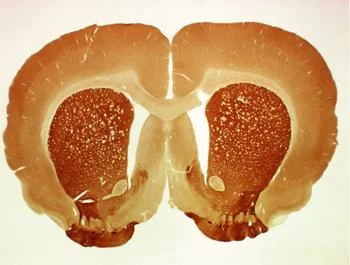Answer: The majority of cells in the rodent striatum are medium spiny neurons, also called spiny projection neurons. There are also several types of GABA-ergic interneurons, as well as TH-expressing cells and cholinergic interneurons.
From https://www.the-scientist.com/technology-profile/a-weighty-matter-neuropeptides-involved-in-appetite-and-energy-homeostasis-56375
The striatum is a major part of the basal ganglia circuitry. It is important for motor learning, habit formation, and the reward pathway. It receives inputs from the thalamus and cortex, and sends projections out to the globus pallidus and substantia nigra.
The overwhelming majority of cell type in the striatum is the medium spiny neurons (MSN), also called the spiny projection neurons (SPN). They make up about 95% of all cells in the striatum. They release GABA, an inhibitory neurotransmitter. In general, they are divided into two classes. The medium spiny neurons (spiny projection neurons) that express the dopamine D1 receptor are also called the direct pathway neurons, and these project to and inhibit the substantia nigra. The remaining MSNs (SPNs) express the dopamine D2 receptor, and are called the indirect pathway neurons. These project to an inhibit the globus pallidus.
Generally, these projection neurons are spontaneously active in the anesthetized or awake behaving animal preparation. They may exist in a down-state or up-state. During the upstate, the cells are more excitable and respond to excitatory neurotransmitter signaling by increasing their firing rate. However, these neurons are silent in the brain slice preparation.
The remaining 5% of neurons in the striatum are predominantly GABA releasing neurons that project locally. These are often classified based on their electrophysiological properties and the expression of various neurochemical components.
Fast spiking interneurons (FSIs) express parvalbumin. They are spontaneously active in a slice preparation. They are able to spike at a rate up to 200 Hz.
Neurogliaform neurons express neuropeptide Y.
Persistent low-threshold spiking interneurons (PLTSi) also express neuropeptide Y. They are silent in the slice preparation.
Cholinergic interneurons are large, a spiny neurons that produce and release acetylcholine. They fire spontaneously.
The tyrosine hydroxylase positive cells and calretinin expressing cells are very poorly understood.
